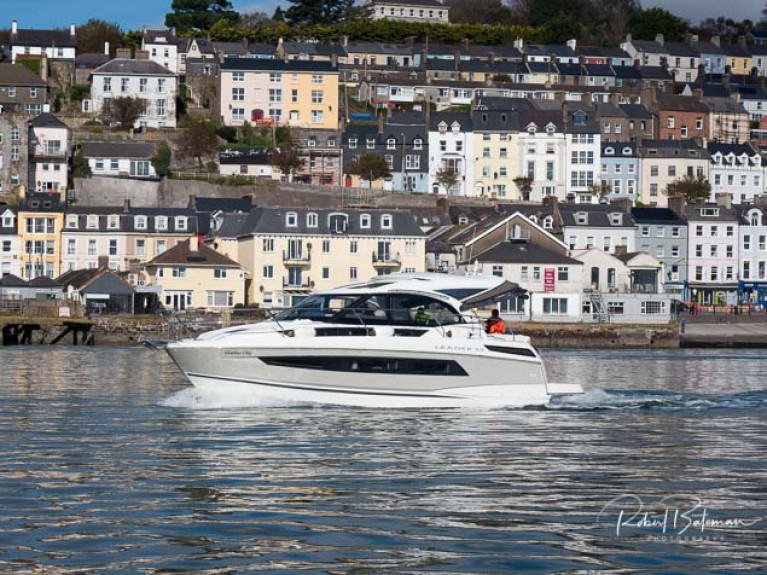Displaying items by tag: Leader
Ilen Departure from Dun Laoghaire Harbour Marks Start of Conor O'Brien’s Saoirse Centenary Celebrations
The Royal Irish Yacht Club was the focus on Saturday afternoon for the beginning of celebrations of the centenary of Conor O'Brien's departure in Saoirse from Dun Laoghaire Harbour on his pioneering global circumnavigation.
An Irish Cruising Club/Royal Cruising Club gathering was hosted by Royal Irish Commodore Jerome Dowling and ICC Commodore David Beattie, with O'Brien's restored ketch Ilen moored alongside the clubhouse.
 Historic ketch Ilen departs Dun Laoghaire Harbour. Constructed in 1926 and rebuilt in 2018, Ilen is based in Kinsale and operated by Sailing Into Wellness
Historic ketch Ilen departs Dun Laoghaire Harbour. Constructed in 1926 and rebuilt in 2018, Ilen is based in Kinsale and operated by Sailing Into Wellness
It was also an occasion when Ireland’s sail training gaff ketch fleet, the Ilen, the Leader and Brian Ború, were in the same harbour for the first time and they came together to mark the famous departure by sailing in procession in a misty Dublin Bay.
The three boats left the RIYC and Dun Laoghaire Marina at 4.30 pm, accompanied by a flotilla of ICC yachts and RIBs, and motor sailed down to the Muglins Rock at the southern tip of Dublin Bay before hoisting sail.
 While each of the sail training gaff ketches has sailed alongside one of the others over the past two years, the three have never been together. From left, Ilen, Leader and Brian Ború motor sail out of Dun Laoghaire Harbour in a sea mist as part of commemorations to mark the centenary of the 1923 departure of Conor O'Brien from Dun Laoghaire on his global circumnavigation
While each of the sail training gaff ketches has sailed alongside one of the others over the past two years, the three have never been together. From left, Ilen, Leader and Brian Ború motor sail out of Dun Laoghaire Harbour in a sea mist as part of commemorations to mark the centenary of the 1923 departure of Conor O'Brien from Dun Laoghaire on his global circumnavigation
As Afloat reports, a hundred years ago, next Tuesday, June 20th, O'Brien took his departure aboard his 42-ft Saoirse from the harbour and headed south.
Unfortunately, Saturday's tribute saw the boats become shrouded in a sea mist as they reached the edge of the bay.
 Leader is the oldest of the three ketches, built in 1892, a Brixham Trawler based in Newry operated by Silvery Light Sailing
Leader is the oldest of the three ketches, built in 1892, a Brixham Trawler based in Newry operated by Silvery Light Sailing
The three ketches bore away to the north east on a starboard reach in a synchronised fashion.
The Ilen then headed south to Madeira as part of the centenary celebrations, Leader headed northabout to Clare Island, and Brian Ború returned to Dun Laoghaire.
 Brian Ború is the baby of the fleet at 61 years old and is based in Dun Laoghaire, operated by Dublin Under Sail
Brian Ború is the baby of the fleet at 61 years old and is based in Dun Laoghaire, operated by Dublin Under Sail
The great voyage of the Saoirse is now seen as a cornerstone of world sailing history.
As Afloat reported earlier, in 1923 she was noticed by only a few when she arrived in Madeira, but this time the Ilen – with the initial flotilla expanded to a fleet as Iberian and Mediterranean-based boats of the ICC and the RCC join the trail – will begin an official visit on July 3rd – the Centenary of O’Brien’s arrival – inaugurating a prodigious welcome and round of celebrations.
MGM Boats Celebrate 35 Years of Jeanneau's Leader Line
In 1985, Jeanneau launched the Leader 850, the first unit of a new line and a new market segment: the 'Express motor yacht'.
35 years and 10,000 units later, the Leader Line continue to attract customers with boats offering high performance and a distinctive look, while also adapted for family cruising.
As regular Afloat readers know, the brand is represented in Ireland by agents MGM Boats Ltd where the Leader model is a staple of the Irish motorboat scene.
To celebrate this anniversary, Jeanneau is offering a Limited-Edition Series with its own exclusive hull decoration, gifts pack, and prize competition.
























































